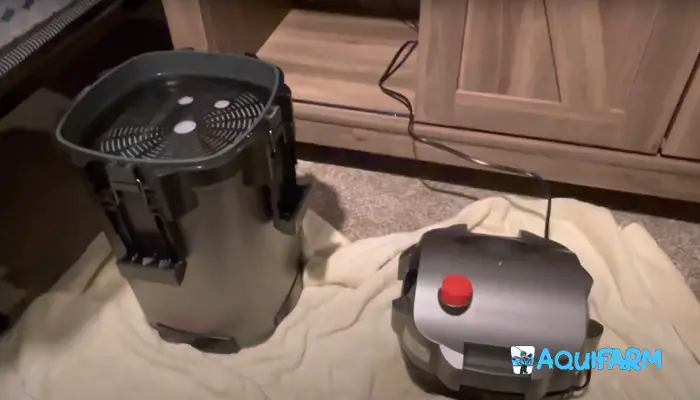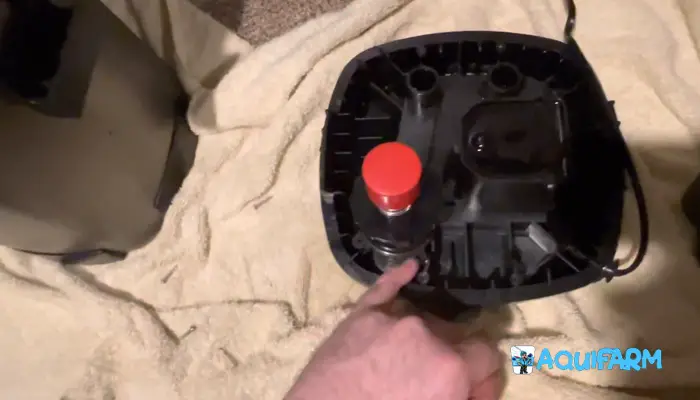
A canister filter making rattling noise is the most troublesome thing that hobbyists face in their aquarium journey. Wherever it can be one of the most favorite types of filters if it is managed properly.
If you are also a sufferer of the same problem, then this is the perfect place for you. Following that, to facilitate your filter condition, I want to provide enough information for you about their maintenance procedure.
Also, I included here the ways to fix the rattling noise of the filter as your aquarium inhabitants feel threatened by the vibrating or rattling sound. Hence, let’s start our journey.
How to Fix Rattling Noise in a Canister Filter- Step by Step

To make you understand the whole fixing process, I have mentioned 10 steps here. Hopefully, it will benefit your filter if you can maintain it properly.
Step-1: Power Off
Before starting the procedure of fixing the rattling noise, you should make sure that the filter is turned off and unplugged. It is important to avoid any unwanted accidents before you start inspecting.
Step-2: Empty the Canister
After that, carefully remove the filter’s canister and then empty its contents. You have to be careful in this case as you need to identify the debris or loose parts that are responsible for causing the noise.
Step-3: Inspect Impeller
As I found in most of the canister filters, the worn impeller is a common source of rattling. That’s why you should check if it’s properly seated or not. Also, it should not be cracked or damaged. Give it a gentle spin to ensure smooth movement.
Step-4: Check Seals and Gaskets
Also, inspect the seals and gaskets that secure the canister components. As you know, damaged or worn seals can cause vibrations and noise. That’s why replace any that are worn out.
Step-5: Secure Loose Parts
After identifying the damaged parts, ensure that all parts within the canister are securely fastened. Loose media, baskets, or components can create noise while the filter is running.
Step-6: Clean Media
Once you have eliminated all the excessive materials, you have to clean the filter media, such as sponges, bio-balls, or ceramic rings. Meanwhile, you have noticed that accumulated debris can cause vibrations and noise.
Step-7: Inspect Tubing
Further, you should examine the tubing and hoses so that any kinks, bends or obstructions cannot be remained in those placed as these are also responsible for causing restricted flow and noise.
Step-8: Check for Debris
For more clarity, look for any debris or foreign objects that might have gotten lodged in the filter components. If there are any, remove them carefully.
Step-9: Reassemble Carefully
As you have completed several checking stages, hopefully, there is no debris remaining in the filter. So, it’s time to put the canister back together.
Complete this process perfectly to ensure that all parts are properly aligned and fitted. Avoid over-tightening as it might cause strain on the components.
Step-10: Restart the Filter
Finally, turn the filter on and observe if the rattling noise persists. If you don’t find any noise again, luckily you’ve gotten rid of the disturbing sound.
If not, consider seeking professional assistance or contacting the manufacturer rather than destroying the filter unconsciously.
Here, I want to remind you to follow the manufacturer’s guidelines for maintenance and troubleshooting to ensure the filter’s optimal performance and longevity.
Why do Canister Filters Create Rattling Noise?

Now, you may ask me what are the causes behind these types of annoying sounds. Well, the causes may be generated from different sources. Let me explain those factors.
1. Loose or Misaligned Components
As you know, canister filters are complex systems having multiple components including impeller shafts, motor mounts, filter media, baskets, and seals.
Consequently, if any of these components are loose or misaligned, they start to create vibrations. As a result, the whole system is misled and rattling noises are created when the filter is running.
More clearly, the movement and friction caused by these components lead to the irritating noise and make you bound to take necessary steps to solve that.
2. Debris
The next cause is debris that can make canister filters produce rattling noises. As these unwanted elements can smoothly float in the water, they can easily disturb the system.
Most of the time, debris might get caught in the impeller or moving parts of the filter due to their smooth-flowing capacity within the filter. As a result, they disrupt the system balance causing vibrations and rattling noise.
3. Trapped Air
After that let’s talk about trapped air which is the most annoying point to me. As I found in my filter, trapped air can create pockets of turbulence.
As a result, the water tries to push past the air bubbles. Whenever the water completes this process, the trapped air creates rattling sounds by engaging in friction with the water.
4. Worn Impeller
The final cause that I am going to describe is the worn impeller. Most hobbyists experience that a rattling noise in a canister filter is often caused by a worn impeller.
When the impeller becomes worn or damaged, it can start to wobble or move unevenly. Such a movement is opposite to the system’s module path.
As a result, it ends up leading to a rattling sound. This can happen due to regular wear and tear over time. Sometimes it may also hamper the filter function.
Are Fish Sensitive to This Rattling Sound?
Yeah! Many fish are sensitive to rattling sounds, especially if they are sudden or loud. Undoubtedly, this type of sound is tough enough for the residents to tolerate continuously.
At the same time, as the sounds are produced due to any type of malfunctioning, it decreases the shelf life of the canister filter and destroys its performance quickly.
But most importantly, it badly affects the fish of the filter. These sounds can startle fish and potentially disrupt their behavior. Also, this is the reason behind initiating stress for the fish.
This is because fish have highly developed hearing systems that are adapted to detecting and interpreting sounds underwater.
Rattling sounds often create low-frequency vibrations which can easily travel through water. As a result, it disrupts their sensory perception.
Also, these sounds can signal danger or indicate changes in the fish environment as the sensitivity of fish to rattling sounds is due to their reliance on sound for communication, navigation, and predator avoidance.
This results in causing fish to respond to ensure their survival, development, breeding process, and issues related to their life cycle.
How Long Can a Canister Filter Run?
Many of my friends ask me about the time they should run a canister filter. Well, you can run canister filters 24/7 as they are designed to run continuously.
Many can run smoothly without any issues. But, for better service, you can keep this shut for 1 to 2 hours a day. However, you should not keep it disconnected for more than one or two days.
Otherwise, it will create safety issues for the aquarium fish. That’s why I always suggest following the manufacturer’s recommendations for maintenance and cleaning to ensure optimal performance and longevity.
How Can I Prevent Sound Production In My Canister Filter?
After sorting out all the issues related to rattling noise production, the most important thing you should maintain is to be concerned so that such problems cannot occur again.
Otherwise, you have to go through these cleaning processes again and again. To assist you in this case, I may list down some points that you should follow regularly to get rid of this problem.
Proper Placement
Ensure that the filter is placed on a level surface so that all the components can be securely fitted. It will prevent vibrations and misalignment that can lead to noise.
Check Impeller
You should inspect the impeller regularly for debris or damage. A damaged impeller can create unusual sounds.
Air Trapped
As air bubbles can create gurgling or humming sounds, make sure that there is no trapped air inside the filter or the tubing.
You can also bleed the air out by gently tilting the filter or using the provided air-release valves.
Soundproofing
You can also use soundproofing materials around the filter to minimize noise transmission. Also, consider placing the filter on a soft mat or foam pad to absorb vibrations.
Regular Maintenance
Clean the filter media at regular intervals to prevent clogs and buildup that could lead to increased noise.
Water Level
You should be conscious about the water level in the filter which should be at an appropriate level. Low water levels can lead to splashing noises.
Upgrade Components
If needed, you can upgrade your filter components to a higher-quality model with a better design which helps reduce noise.
Check for Defects
Occasionally, some canister filters might have manufacturing defects that lead to excessive noise. If your filter is under warranty, consider reaching out to the manufacturer for a replacement.
FAQs
What should I do if I find loose parts?
If you find any loose clamps, connections, or components in your canister filter, tighten that loose part. This might involve adjusting the positioning of hoses, seals, and impeller covers.
How do I get rid of air bubbles in the canister filter?
By tilting the filter slightly, you can get rid of air bubbles. You have to ensure that the canister is properly primed and that the hoses are free from air pockets.
Is there a way to lubricate parts to reduce noise?
Yeah! Some filters allow for lubricating parts like impellers or gaskets that can reduce noise. But if they can’t work properly, they may also be the cause of producing rattling sounds.
Can water flow affect noise production?
Yes! I found it in my canister filter. If the water flow is too high, it can create turbulence and noise. In that case, you have to adjust the flow rate to a level that reduces turbulence while still maintaining efficient filtration.
Final Thoughts
However, I would like to end here as I think you have found your answer within this time. The nagging sounds of canister filters may stress you much along with the fish.
That’s why try to follow the rules for saving your filter from producing such repelling sounds and also ensure that such problems cannot be back again due to your unconsciousness.
Hopefully, this information will help you to fix your canister filter problems. If you can’t solve it personally, you can consult with the experts or knock me personally pointing at your specific problems.
- Top 15 Freshwater Aquarium Plant Ideas for a Lush, Green Tank - November 9, 2024
- Top 13 Freshwater Aquarium Layout Ideas for a Beautifully Organized Tank - November 9, 2024
- 14 Stunning Rustic Freshwater Aquarium Ideas for a Tranquil Environment - November 9, 2024
